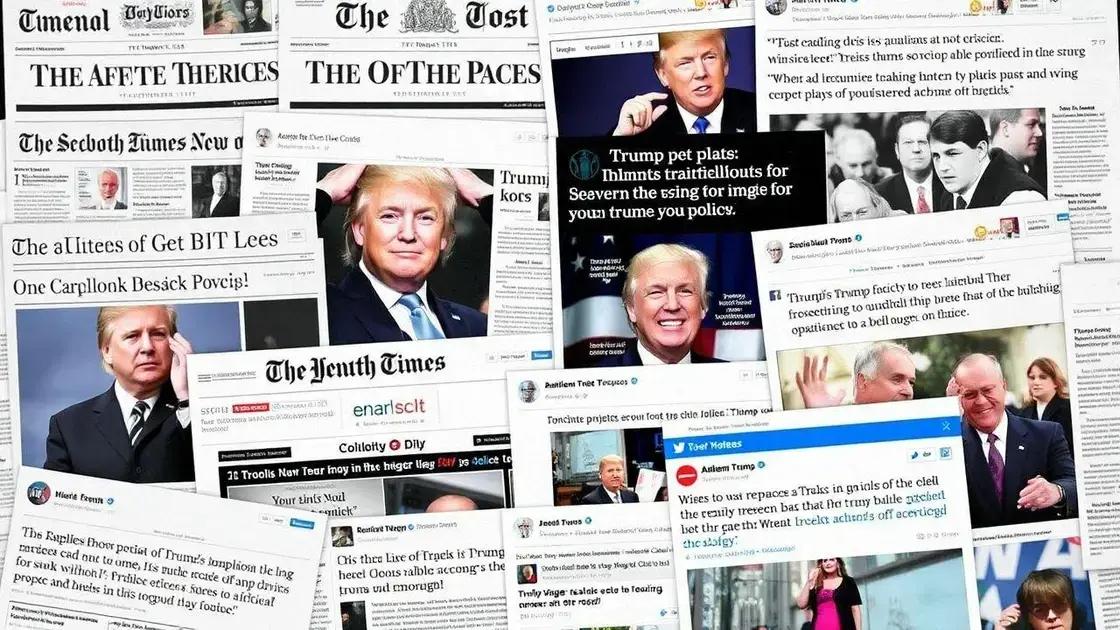Polls reveal shifting public opinion against Trump’s policy proposals

Anúncios
Polls reveal shifting public opinion against Trump’s policy proposals, highlighting diverse demographic concerns and the significant impact of media coverage on perceptions and future political outcomes.
Polls reveal shifting public opinion against Trump’s policy proposals. This evolving perspective raises questions about political strategies and voter priorities. Have you noticed how opinions seem to fluctuate over time? Let’s dive into what the latest data says.
Anúncios
Recent trends in public opinion
Recent trends show that public opinion is evolving rapidly, especially when it comes to Trump’s policies. As we navigate through changing political landscapes, understanding these shifts is crucial. For many, the perception of Trump’s policy proposals has changed over time.
Shifts in Approval Ratings
Polls indicate significant fluctuations in approval ratings for Trump’s proposals. The numbers suggest that many voters are reconsidering their positions. Key influencing factors often include:
Anúncios
- Media portrayal of policies
- Economic indicators and their impact on daily life
- Responses from political opponents
These factors play an important role in shaping public perception, contributing to a dynamic political environment.
Engagement of Younger Voters
One notable trend is the increasing engagement of younger voters. This demographic has shown a stronger inclination to voice their opinions on Trump’s policies. As social issues take center stage, younger generations are more vocal about their preferences and concerns. This shifting public opinion could be pivotal for upcoming elections, particularly as they:
- Prioritize climate change and sustainability
- Demand more inclusive social policies
- Seek economic stability and job opportunities
Their participation in polls reflects a broader desire for change, influencing overall opinions significantly.
In summary, recent trends in public opinion reveal a complex and evolving landscape regarding Trump’s policy proposals. Understanding these dynamics is essential for grasping how political narratives are framed today.
Key policy proposals under scrutiny
Key policy proposals under scrutiny highlight the concerns and reactions of the public toward Trump’s agenda. Many proposals have sparked debates, showcasing a spectrum of opinions and creating a vibrant political discourse. Among these, a few critical areas often draw the most attention.
Immigration Policies
Trump’s immigration policies have consistently stood out. These proposals aim to tighten border controls and limit immigration rates. While some support these measures for national security, others argue they can harm the nation’s economy and cultural diversity.
- Challenges to family reunification
- Increased deportation efforts
- Changes to asylum processes
The mixed reactions to these policies underscore a divide among voters, highlighting fears and values shaped by personal experiences.
Healthcare Reforms
Another area of concern is the reform of healthcare systems. Proposals to repeal or replace the Affordable Care Act have faced backlash, particularly among those who rely on its protections. Many worry that such changes could lead to loss of coverage.
- Impact on pre-existing condition coverage
- Access to affordable medications
- Potential increases in uninsured rates
As discussions evolve, public opinion continues to shape these proposals, forcing policymakers to reconsider their approaches and strategies.
Finally, economic policies also attract scrutiny. Tax reform and trade policies have sparked debates about their long-term economic impact. Many individuals express concerns regarding:
- Wealth inequality
- Job creation and stability
- Trade agreements and tariffs
Understanding these policy proposals is essential for grasping the broader implications for society and individual lives.
Impact of media coverage on perceptions

The impact of media coverage on perceptions cannot be overstated, especially regarding Trump’s policies. The way news is presented influences public opinion significantly. Many people rely on news outlets to form their views, making it essential to understand how coverage shapes perceptions.
Framing of Issues
Media framing plays a crucial role in how audiences interpret information. When policies are reported in a particular light, the public may respond differently than if the information were presented otherwise. For instance, if immigration policies are framed as a security issue, it may drive support for stricter measures.
- Emphasis on negative aspects increases skepticism
- Highlighting positive stories can build support
- Use of emotive language can sway opinions
These subtle shifts in framing can lead to significant differences in public reactions.
Social Media’s Role
Social media has revolutionized the way information spreads. Platforms like Twitter and Facebook allow users to share articles and opinions widely. This sharing creates echo chambers where individuals may only see perspectives that align with their own. This phenomenon can amplify certain viewpoints and obscure others, which affects public discourse.
- Viral posts can quickly shape public sentiment
- Influencers can sway their followers’ opinions
- Disinformation can spread rapidly, altering perceptions
As a result, social media can distort perceptions of reality, leading to a divided understanding of Trump’s policies.
Moreover, consistent media coverage can establish narratives that might not reflect the full truth. Over time, the repetition of specific themes can normalize certain perceptions while marginalizing dissenting voices. It’s vital for consumers to critically evaluate the media they consume to gain a balanced understanding of the issues.
Voices from different demographics
Voices from different demographics provide valuable insights into how various groups perceive Trump’s policies. From young voters to senior citizens, each demographic has distinct concerns and priorities, shaping their views on political issues.
Young Voters
Young voters often emphasize issues such as climate change and social justice. This group tends to advocate for more progressive policies and is vocal about their opposition to proposals they see as harmful. Their engagement in political discussions is crucial, as they represent the future electorate.
- Increased focus on sustainability
- Support for equitable educational opportunities
- Demand for inclusive social policies
As they mobilize on social media, young voters amplify their voices, influencing the political landscape.
Minority Communities
Minority communities often express concerns about immigration and civil rights. Many feel that Trump’s policies may disproportionately impact them. Voices from these groups highlight the need for comprehensive reforms that address systemic inequality.
- Calls for protection against discrimination
- Concerns over deportation and family separations
- Desire for equitable access to resources
These perspectives are critical in understanding the full impact of policy decisions on society.
Senior Citizens
Senior citizens often focus on healthcare and retirement security. This demographic is concerned about potential changes to Medicare and Social Security, fearing that cuts could diminish their quality of life. Their experiences and needs shape a more cautious approach to policy acceptance.
- Importance of affordable healthcare
- Stability of social safety nets
- Access to services for aging populations
Through their advocacy, seniors can sway opinions and mobilize support for issues that matter most to them.
When looking at these diverse voices, it’s clear that varying backgrounds influence perspectives on Trump’s policy proposals. Bridging these voices may foster understanding and collaboration, leading to more nuanced political discussions.
Future implications for Trump’s policies
Future implications for Trump’s policies will shape the political landscape in significant ways. As public opinion continues to shift, the effects of these policies will be felt across various sectors, influencing everything from elections to social movements.
Impact on Upcoming Elections
As elections approach, the reception of Trump’s policies will play a crucial role. Candidates may leverage public sentiment to either endorse or oppose these policies. The ability to connect with voters who feel strongly about specific proposals could determine election outcomes.
- Candidates aligning with popular opinions may gain support
- Opposition may rally voters dissatisfied with current policies
- Shifts in demographics can alter traditional voting patterns
Understanding these dynamics allows political strategists to tailor their messages effectively.
Social Movements and Activism
Social movements are likely to evolve in response to Trump’s policy proposals. Activists are already mobilizing around issues like immigration and healthcare, seeking to challenge policies they view as unjust. The increased visibility of these movements can foster greater public engagement.
- Grassroots organizations may gain momentum
- Coalitions across demographics can amplify voices
- Increased advocacy for change at local and national levels
These efforts can influence future policy decisions, pushing lawmakers to address pressing concerns.
Long-Term Policy Reforms
Trump’s policies may also prompt long-term reforms that reshape the political landscape. If certain proposals gain traction, they could establish a new status quo, with lasting impacts on government and society. For instance, healthcare and immigration reforms could set precedents for future legislation.
- Potential for new legislative frameworks
- Changes in how policies are evaluated
- Influence on the Republican Party’s platform
Monitoring these changes will be key for stakeholders when considering their strategies moving forward.
In summary, the future implications for Trump’s policies encompass a broad range of factors that will play a vital role in not just politics, but also societal structures and community dynamics.
In conclusion, understanding the evolving landscape of public opinion regarding Trump’s policies is essential for grasping the political climate. Various demographics are shaping dialogue, and media coverage plays a vital role in framing perceptions. The implications of these trends will influence not just upcoming elections, but also the future of policy reform and social movements. As these voices are amplified, they can foster a more engaged electorate, pushing for changes that reflect the diverse needs of society.
FAQ – Frequently Asked Questions about Trump’s Policies
How are public opinions influencing upcoming elections?
Public opinions are shaping candidates’ platforms, making it essential for them to address key issues that resonate with voters.
What role does media coverage play in shaping perceptions?
Media coverage significantly affects how policies are viewed, influencing public sentiment through framing and emphasis on specific narratives.
How are different demographics expressing their voices?
Various demographic groups are vocal about their concerns, advocating for changes on issues like healthcare, climate, and social justice.
What implications do Trump’s policies have for future reforms?
Trump’s policies could establish a new political landscape, prompting long-term reforms that may reshape government and societal norms.






